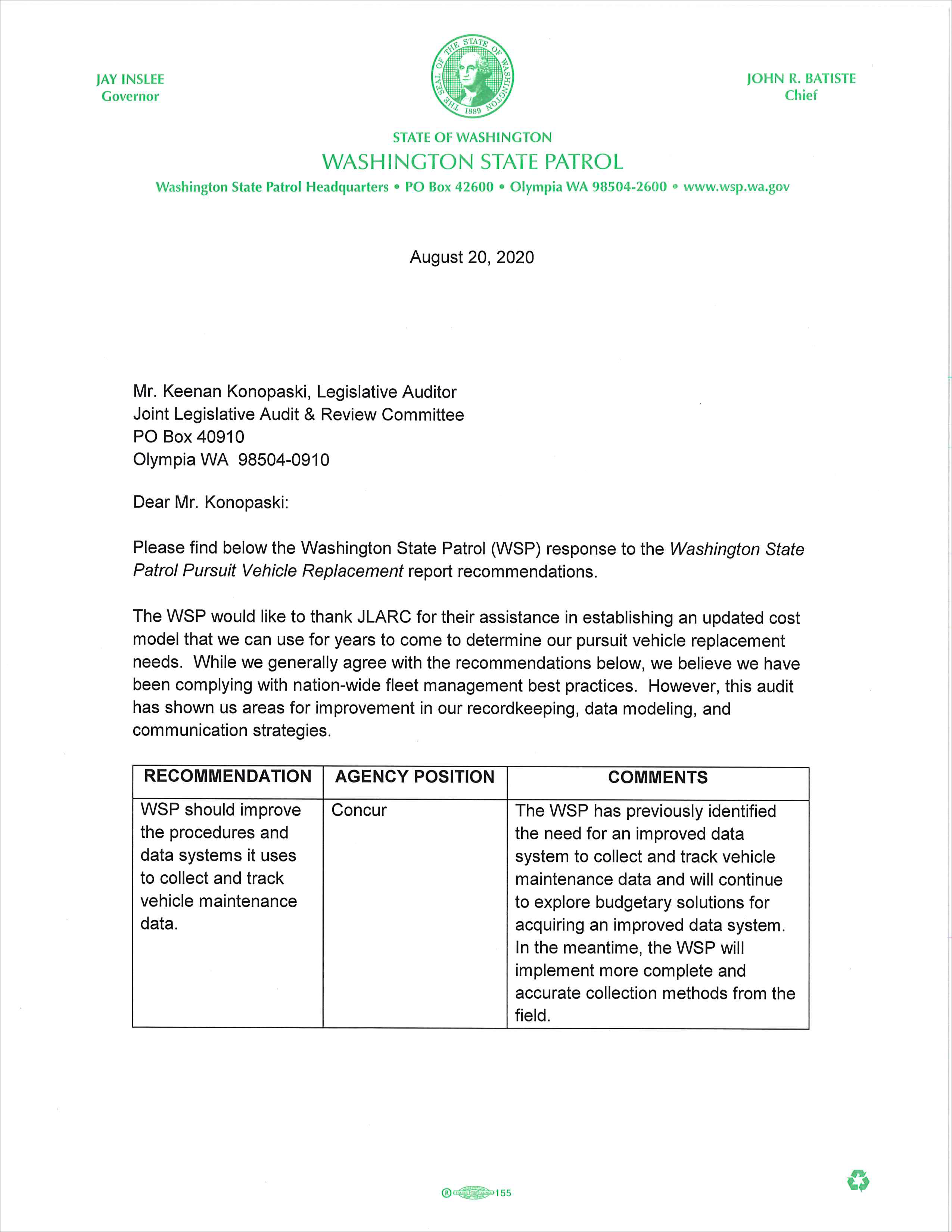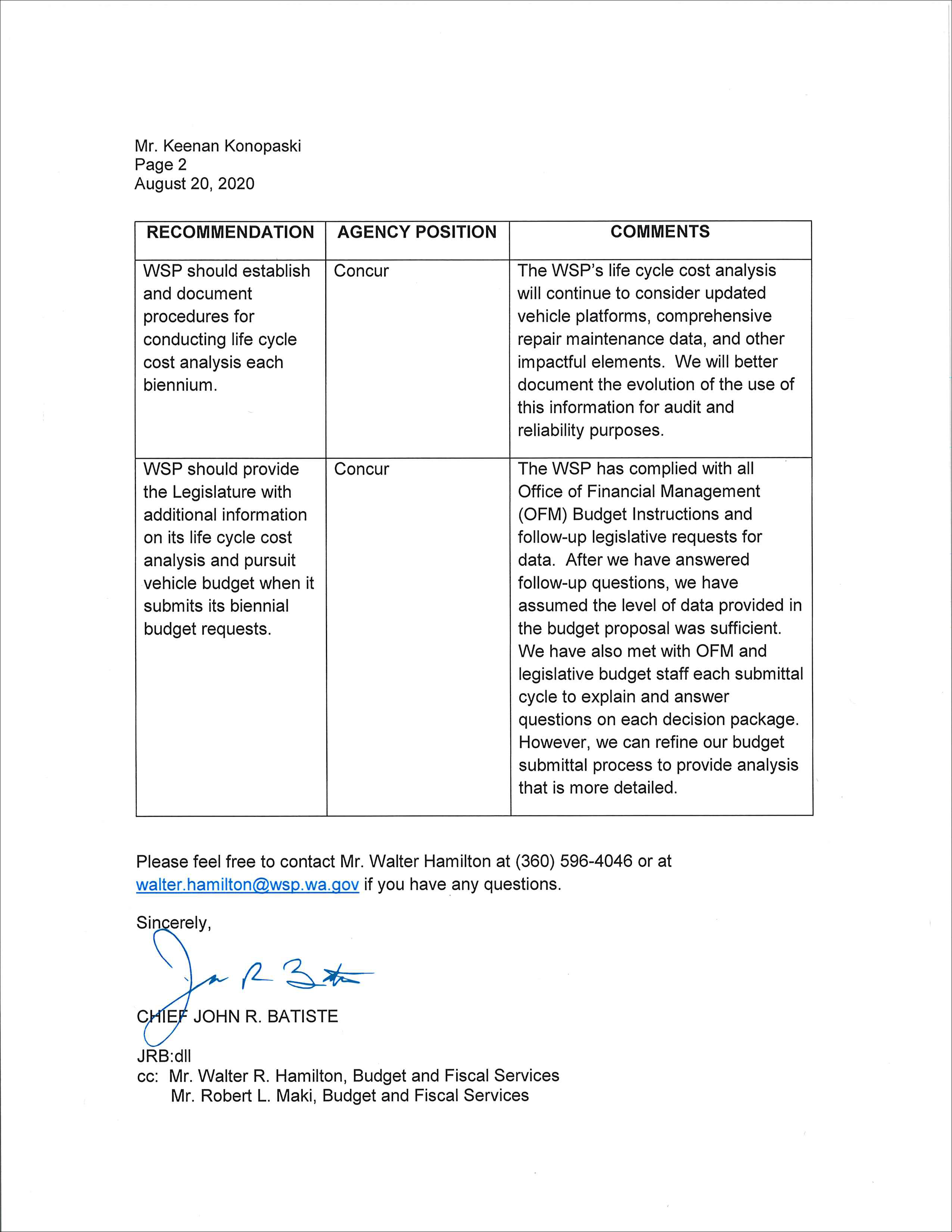The Washington State Patrol (WSP) planned to spend $13.3 million to purchase and equip 240 new pursuit vehicles in the 2019-21 biennium
WSP planned to spend just under 50% of its 2019-21 pursuit vehicleStandard vehicles that are modified to perform under the rigors of police use. budget on capital costs, including purchasing new vehicles and equipment. It planned to spend $14.4 million on operating costs, such as fuel, maintenance, and parts.

The average replacement mileage in 2019 was 118,000
WSP conducts life cycle cost analysis to determine the optimal replacement mileage for the Ford Police Interceptor Utility (Interceptor), the agency's primary pursuit vehicle. According to the agency's analysis, the optimal replacement targetThe mileage interval where total life cycle costs per mile are lowest. for the Ford Interceptor is 110,000 miles for the 2019-21 biennium. In practice, WSP replaced Interceptors when they reached an average of 118,000 miles in 2019.
WSP is not following best practices for using life cycle cost analysis and communicating results. This limits the accuracy of the analysis and its impact on policy and funding decisions.
WSP purchased a new pursuit vehicle life cycle cost model in 2004 from the National Association of Fleet Administrators. WSP updates the data in its model every two years in advance of its biennial budget request. The results help to inform WSP's funding request for vehicle expenditures in the upcoming biennium.
JLARC staff found that WSP is not following best practices for updating and documenting life cycle cost analysis and communicating the results.
- WSP provides limited oversight of data entry, leading to significant outliers and incomplete records. Better data could improve overall fleet management and increase the accuracy of the life cycle cost model.
- The model does not follow standard modeling guidelines such as using consistent formulas or discounting costs to their present value. A coding error prevents the model from accurately displaying life cycle costs beyond 110,000 miles.
- WSP did not adequately document the assumptions and methodologies used to update the 2019-21 life cycle cost model. As a result, JLARC staff were unable to verify the cost inputs in the model. In addition, WSP cannot accurately track how costs and other inputs have changed over time.
- The narrative summary submitted to the Legislature lacked detail and did not include a copy of the 2019-21 life cycle model. This prevents legislative staff from reviewing and verifying the analysis that led to the 110,000 mile replacement target.
JLARC staff's analysis indicates an optimal replacement target of 130,000 miles. A replacement decision should also consider other important factors.
JLARC staff modified the structure and content of the model to align with available fleet data and incorporate best practices for life cycle costing. Based on the updated analysis, JLARC staff identified an optimal replacement range from 130,000 miles to 175,000 miles.
After adjusting for costs and factors not included in the model, JLARC staff determined an optimal replacement target of 130,000 miles.
Some of the other considerations include:
- How vehicle downtime When vehicles are inactive due to maintenance work. effects the size of the fleet and trooper availability.
- The level of uncertainty around maintenance costs and vehicle reliability at higher mileages.
- The desire to keep the fleet up to date with the newest safety features.

Source: JLARC staff analysis of WSP fleet data.
Rising costs to purchase and equip vehicles may increase the optimal replacement mileage, though other future costs are less certain
WSP's transition from the Ford Interceptor to the Ford Interceptor EcoBoost, by itself, is expected to increase purchase costs by 11% in 2019-21. JLARC staff's analysis found that the additional costs could increase the optimal replacement target by as much as 16,500 miles. However, other costs that impact the optimal replacement mileage are less certain, such as maintenance on the new vehicle model.
Legislative Auditor Recommendations
The Legislative Auditor makes three recommendations to improve fleet management.
- WSP should improve the procedures and data systems it uses to collect and track vehicle maintenance data.
- WSP should establish and document procedures for conducting life cycle cost analysis each biennium.
- WSP should provide the Legislature with additional information on its life cycle cost analysis and pursuit vehicle budget when it submits its biennial budget requests.
The Washington State Patrol and Office of Financial Management concur with these recommendations. You can find additional information in Recommendations.
Committee Action to Distribute
On September 30, 2020 this report was approved for distribution by the Joint Legislative Audit and Review Committee. Action to distribute this report does not imply the Committee agrees or disagrees with Legislative Auditor recommendations.















